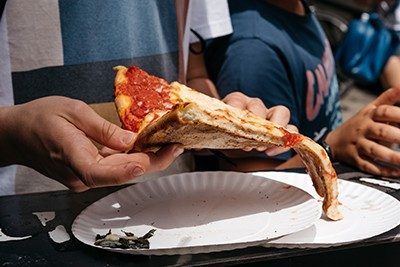FOR IMMEDIATE RELEASE | August 26, 2021
Degradable coatings for compostable paper food packaging block grease and oil
ATLANTA, Aug. 26, 2021 — Cups, cartons and food wrappers made of paper might seem like they would be biodegradable, but many contain a plastic coating that can’t be composted. Although plastic-free, sustainable paper products are available, they often let grease and oil pass through, weakening the paper and creating a mess. Today, scientists report they have developed a degradable polymer coating that can block this seepage and could lead to new biodegradable, paper-based materials.
The researchers will present their results at the fall meeting of the American Chemical Society (ACS). ACS Fall 2021 is a hybrid meeting being held virtually and in-person Aug. 22-26, and on-demand content will be available Aug. 30-Sept. 30. The meeting features more than 7,000 presentations on a wide range of science topics.
"Consumers are driving a push to more sustainable products,” says Matthew Carter, Ph.D., principal investigator on the project. “But making a fully degradable paper product for single-use applications — like the sandwich wrappers, bowls and trays you get at a cafeteria — is a big challenge,” adds Carter, who is presenting the work at the meeting.
Current oil- and grease-resistant coatings for disposable paper products often include fluorocarbons or polyolefins, but those polymers are environmentally persistent and can’t be composted. “One of the things that makes conventional polymers useful is their durability,” says his fellow principal investigator, Andrew Hejl, Ph.D., who works with Carter at Dow. That toughness, which originates in the stable carbon-carbon bonds that form during polymerization, is desirable in, say, a latex-based house paint that must last for years but problematic in a paper bowl destined for composting.
One way to make polymers less durable is to insert degradable linkages to disrupt their carbon-carbon backbones, Carter says. To do so, the researchers turned to a free radical polymerization technique that had been around for years but hadn’t been widely adopted. Noticing a recent resurgence of interest in academia for using this technique with cyclic ketene acetal and vinyl monomers, the Dow team began exploring how to translate this chemistry to an industrial setting. In academia, the reaction was typically carried out in organic solvents, but Dow wanted to switch to water as a “greener” substitute. That was difficult because cyclic ketene acetal monomers are unstable in water, but the researchers addressed that problem by tweaking reaction conditions, including pH, temperature and monomer concentration.
Their reaction mixed the cyclic ketene acetal 2-methylene-1,3-dioxepane and vinyl acetate to form a polymer with ester linkages in the backbone. The team then coated paper with a water-based emulsion of this polymer — a synthetic “latex” unrelated to natural latex rubber, and therefore unlikely to trigger an allergic reaction — and let it dry. They recently reported that the coating provided an effective barrier against oil and grease, and that its ester linkages could break apart in water, quite slowly at neutral pH but faster at higher pH under lab conditions. Now, the researchers are beginning to assess the coating’s degradability under industrially relevant conditions. So far they have shown that microorganisms that are used in industrial composters can help biodegrade the polymer in simulated wastewater. “The concept is to have a long polymer that breaks down into smaller pieces that will ultimately get broken down by microbes into CO2,” Hejl says.
Other researchers and companies have developed biodegradable food service products with coatings based on natural materials such as whey or chitosan. “Those are great options, but they have limitations in terms of getting the performance you want at an appropriate price point,” Hejl says. And some coatings have to be applied as a very dilute solution, so a lot of water has to be evaporated to dry them, he adds. “So there are a lot of potential materials, and I don't think that anything yet has checked off every box.” But the Dow researchers believe their coating might just fill the bill.
“More broadly, if you look at the concept of interrupting a stable carbon-carbon backbone with degradable linkages, that really opens up a lot of opportunities beyond just paper coatings,” Carter says. “Other applications include personal care or home care formulations, like shampoo and floor polish. Many of these materials currently contain synthetic carbon-carbon bond polymers. So this approach could be a powerful way to introduce degradability to new classes of materials in the future.”
The researchers acknowledge support and funding from Dow.
To automatically receive press releases from the American Chemical Society, contact newsroom@acs.org.
Note: ACS does not conduct research, but publishes and publicizes peer-reviewed scientific studies.
Media Contact
ACS Newsroom
newsroom@acs.org


